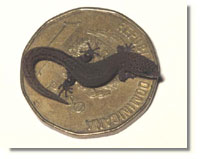 |
|
|
 |
||
| |||||||||||||||||
|
|||||||||||||||||
|
Media contact: |
Cheryl Dybas |
(703) 292-8070 |
|
|
Program contact: |
Lawrence Page |
(703) 292-8481 |
|
|
|
|||
![]()
World's Smallest Lizard Discovered in the Caribbean
|
The world's smallest lizard has been discovered on a tiny Caribbean island off the coast of the Dominican Republic. The newly discovered species not only ranks as the smallest lizard, but it also is the smallest of all 23,000 species of reptiles, birds, and mammals, according to a paper published in the December issue of the Caribbean Journal of Science. Blair Hedges, an evolutionary biologist at Penn State, and Richard Thomas, a biologist at the University of Puerto Rico, are co-authors. The National Science Foundation (NSF) funded their research. "Many extraordinary species still await discovery and, unfortunately, the time left to discover them is rapidly disappearing because of habitat destruction and other forms of environmental degradation," says Larry Page, program director in NSF's division of environmental biology. "This discovery of what appears to be the world's smallest reptile is particularly interesting because of the physiological constraints associated with decreasing body size. Discoveries of unusual organisms have a great deal to tell us about biological evolution and our environment." So small it can curl up on a dime or stretch out on a quarter, a typical adult of the species Sphaerodactylus ariasae is only about 16 millimeters long, or about three quarters of an inch, from the tip of the snout to the base of the tail. It shares the title of "smallest" with another lizard species named Sphaerodactylus parthenopion, discovered in 1965 in the British Virgin Islands. Hedges and Thomas found small groups of the new species living in a sink hole and a cave in a partially destroyed forest on the remote island of Beata, which is part of the Dominican Republic's Jaragua National Park. "Our discovery illustrates that we still don't know everything about the Earth's species, even in areas that are very close to the United States," Hedges says. "The island home of this tiny lizard is closer to Miami than Miami is to Puerto Rico, and we did not even know the species existed, although the area has been studied by biologists for several hundred years." Hedges says the habitat that this species needs to survive is disappearing rapidly. "People are cutting down trees even within the national parks and, if they take the forest away, these lizards and other species will disappear." Hedges and Thomas went to Isla Beata specifically to discover previously unknown species that might be living there. The "smallest" and "largest" species of animals tend to be found on islands, the researchers say, because species can evolve there over time to fill ecological niches in the habitat left vacant by other organisms that never reached the remote locations. If a species of spider is missing from an island, for example, the lizards there might evolve into a very small species to "fill" the missing spider's ecological niche. "It is hard to say whether this lizard is as small as a lizard can get, but you would think it probably is approaching that limit because it is the smallest of all 23,000 known species of reptiles, birds and mammals," Hedges says. "The smaller an animal gets, the larger its surface area gets as a percentage of the volume or mass of its body. At some point, it gets to be physiologically impossible to get any smaller." For the lizard, which lives in a dry environment surrounded by comparatively moist leaf litter, the limiting factor is the danger of desiccation. "If we don't provide a moist environment when we collect them, they rapidly shrivel right up and die by evaporation from the proportionally large area of their surface," Hedges explains. |
All photos copyright S. Blair Hedges
A larger
version is here.
A larger version is here. Photo credit: Copyright
S. Blair Hedges
A larger version is here. Photo credit: Copyright
S. Blair Hedges
A larger version is here. Photo credit: Copyright
S. Blair Hedges
A larger version is here. Photo credit: Copyright
S. Blair Hedges
A larger version is here.
|
|
|





